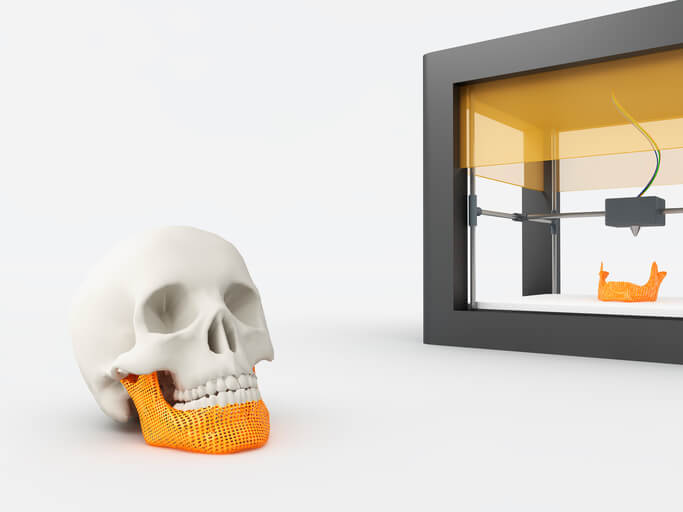The newest developments in 3D bioprinting and living ink
The 3D printing refers to the process of making a physical object using a 3-dimensional digital model. Till date, we have known about the 3D printing technology that is using dead matter such as resins, metals, and thermoplastics but now, the scientists have successfully researched about the 3D printers for printing living devices by embedding bacteria in a biocompatible 3D printing ink.
An expert research panel has developed an exceptional 3D printing technique by genetically modifying the cells for designing a ‘live tattoo.’ A live tattoo is a successful result from a living ink, ink that is renewable and sustainable to transform the carbon dioxide into the ink by using algae.
The 3D printing on living devices is made fruitful by using a technology in which the hydrogel inks are programmed with the bacteria cells (as sensitive components) into the large-scale living materials.
In short, the 3D printing on living devices is made successful with the combination of the hydrogel, bacteria, algae nutrients and other microbes to sustain as well as maintain the cell functionality.
The 3D printing living devices, also known as 3D bioprinting devices have proved as a boon to the healthcare sector. The technology is successfully used in the healthcare sector for both generation and transplantation of many tissues including the skin, vascular grafts, bones, heart tissue, tracheal splints, etc. The technology is also widely used for the burn victims, pharmacology, and tissue engineering.
Being an alternative solution for accessing organs that are bioficial, the 3D bioprinting expands its advantage to the entire healthcare market.
The 3D bioprinting healthcare market is estimated to reach USD 581 million by 2022 at a CAGR of 21.7%. The healthcare market has geographically benefited too with the development of 3D bioprinting considering Europe as the next leading region after North America. The APAC is also one of the highest growing healthcare sectors in 3D bioprinting with the highest CAGR.
There are many other applications and uses of the 3D bioprinting, which is responsible for its success and advantage to the healthcare sector. other 3D bioprinting applications are tissue engineering, drug discovery and testing, regenerative medicine and research and development.
| Recommended for you | |
| Top 10 companies in the medical 3D printing | |
| Now, print your hand: 3D printed prosthetics | |
| 3D printing is already old school: 4D printing revolution in healthcare |
Key players developing devices with 3D printing and living ink
The 3D bioprinting has transformed the healthcare segment in many ways. Getting motivated from the benefits and advantages of the 3D printing and living ink, there are many emerging companies taking the initiative to map the road ahead for the healthcare industry.
The key players of the 3D bioprinting industry are RegenHU Ltd, Cellink AB, EnvisionTEC, 3Dynamic System, Nano 3D biosciences, Poietis, Organovo Holdings Inc, Advanced Solutions Inc, Cyfuse Biomedical, 3D Bioprinting Solutions and GeSIM to name a few. These national and International 3D bioprinting companies are taking keen steps for launching the benefits of 3D printing and ink into the healthcare industry via partnerships, research, agreements, collaborations, expansion, consolidation and product development.
The Organovo Holdings Inc has developed exVive3D liver tissue for medicine testing, which has been adopted in healthcare segment by recognized companies like L’Oreal and Merck. The company is also planning for the launch of exVive3D kidney tissue this year.
The other products developed by these industries for healthcare are 3D print thyroid gland, a 3D-printed surgical planning guide for children, Nano3D printing breast cancer tissue, Human nipple tissue, Bio-print dura mater for brain surgery, etc.
There is a different use of the product as per the utility as mentioned above but overall the applications of these products are chiefly utilized for testing and research, different skin, brain and bone surgeries, transplant of glands or organs, fabrication of tissue, cancer research, pediatric care, printed guides, etc.
Apart from the key players who are serving the world with the amazing results of 3D bioprinting products, there are also few Universities which have extended their interest and research in 3D bioprinting and benefits of using living ink. The Indiana University, Wake Forest University, Pennsylvania State University and Advanced Solutions for Life Sciences are using the 3D bioprinting research for creating ears, cartilage and blood cells.
The other organizations such as Biotecnika, Future Learn, Australian Academy and Rice University are also focusing on state of the art technology of living ink for producing seamless results in the healthcare sector.
Conclusion
The 3D printing of living devices has made a significant impact on the healthcare sector. It is because of the successful research and development of the great universities and critical industries; we can get an opportunity to generate specific tissue for the treatment of chronic as well as personalized diseases.
Apart from the producing the fabric tissues, the 3D bioprinting has also helped the world healthcare market with customization and personalization of the medical products and drugs. The 3D medical or bioprinting is revolutionizing healthcare with a new wave of advancement in the treatments and surgeries. It is one of the safest ways to fabricate human tissue with reduced risk and cost.
Currently, the 3D printing industry is worth 700 million USD with 11 million USD invested in the medical applications and healthcare sector. In the coming years, the 3D bioprinting industry is expecting a great boom considering 20% of the total share of the 3D digital printing industry.
With an increase in the global market share, the 3D bioprinting will have a significant impact on the healthcare industry by offering customization and personalization in the medical applications.
It will also help with increased cost efficiency by making medical devices at a cheaper rate with enhanced productivity. The healthcare sector will also be benefited with the decentralization of design and manufacturing of goods with the use of 3D bioprinting. The other applications of 3D bioprinting in the healthcare sector are bioprinting the tissues and organs with the method of depositing the ‘bioink’.
The researchers have already shown excellent results by using the 3D bioprinting for creating a heart valve, spinal disk, and artificial ear; which can be expanded into much more developments with coming time.
Image credit: www.istockphoto.com

















